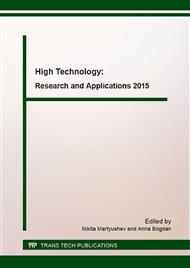[1]
V. M. Kapustin, E.A. Chernysheva, The development of petroleum refining and petroleum chemistry in Russia, Petrol. Chemistry. 4 (2010) 259-266.
DOI: 10.1134/s0965544110040018
Google Scholar
[2]
N.N. Mishin, A.B. Kulikov, A.L. Maksimov, Hydroforming gas oil catalytic cracking using modified NIW-sulfide, Petrol. Chemistry. 5 (2014) 371-380.
Google Scholar
[3]
P.V. Aleksandrov, V.N. Kashkin, G.A. Buhtiyarova, A.L. Nuzdin, A.V. Pashigreva, O.V. Klimov, A.S. Noskov, A comparative study of NIMO/Al2O3 and COMO/Al2O3 catalysts of new generation in the reactions of hydrodesulfurization and hydridenitrorization vacuum gasoil, Neftepererabotka i neftekhimiya. Nauchno-tekhnicheskie dostizheniya i opyt. 9 (2010).
Google Scholar
[4]
R.I. Kuzmina, V.T. Liventsev, T.K. Vetrova, A.A. Kabkov, A.A. Afonin, M.P. Frolov, Influence of sulfur-containing substances on catalytic activity of the reforming catalyst, Butlerov communications. 13 1 (2018) 48-52.
Google Scholar
[5]
P.N. Kuznetsov, L.I. Kuznetsova, A.V. Kazbanova, V.P. Tverdokhlebov, G.M. Zeer, A.P. Kinzul, Physicochemical properties of spent Achinsk refinery reforming platinum-rhenium catalyst, Petrol. Chemistry. 6 (2013) 436-442.
DOI: 10.1134/s096554411306011x
Google Scholar
[6]
E.B. Golushkova, E. Yu. Kovalenko, T.A. Sagachenko, Influence of metal powders on oil component composition, Bulletin of the Tomsk Polytechnic University, 3 (2014) 112-118.
Google Scholar
[7]
J.M. Schmitter, P.J. Arpino, Azaarenes in fuels, Mass spectrometry reviews. 1 (1985) 87-121.
DOI: 10.1002/mas.1280040104
Google Scholar
[8]
A.V. Korshunov, Fundamental aspects of oxidation of electroexplosive nickel nanopowder, Russian Journal of Applied Chemistry, 7 (2011) 1129-1136.
DOI: 10.1134/s1070427211070019
Google Scholar
[9]
А.P. Il'in, L.O. Root, A.V. Mostovshchikov, The Rise of Energy Accumulated in Metal Nanopowders, Technical Physics, 8 (2012) 1178-1180.
DOI: 10.1134/s1063784212080129
Google Scholar
[10]
O.A. Beyko, A.K. Golovko, L.V. Gorbunova, Chemical composition of oils in Western Siberia, Nauka Publ., Novosibirsk, (1988).
Google Scholar


